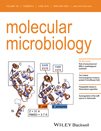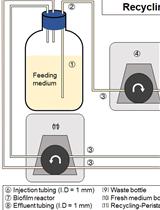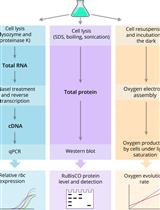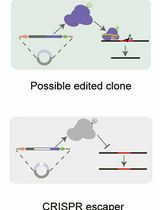- EN - English
- CN - 中文
Fluorescence in situ Localization of Gene Expression Using a lacZ Reporter in the Heterocyst-forming Cyanobacterium Anabaena variabilis
利用lacZ报告基因对形成杂环的蓝藻多变鱼腥藻中的基因表达进行荧光原位定位
发布: 2017年01月05日第7卷第1期 DOI: 10.21769/BioProtoc.2084 浏览次数: 8606
评审: Maria SinetovaManuela RoggianiYoko Eguchi
Abstract
One of the most successful fluorescent proteins, used as a reporter of gene expression in many bacterial, plant and animals, is green fluorescent protein and its modified forms, which also function well in cyanobacteria. However, these fluorescent proteins do not allow rapid and economical quantitation of the reporter gene product, as does the popular reporter gene lacZ, encoding the enzyme β-galactosidase. We provide here a protocol for the in situ localization of β-galactosidase activity in cyanobacterial cells. This allows the same strain to be used for both a simple, quantitative, colorimetric assay with the substrate ortho-nitrophenyl-β-galactoside (ONPG) and for sensitive, fluorescence-based, cell-type localization of gene expression using 5-dodecanolyaminofluorescein di-β-D-galactopyranoside (C12-FDG).
Keywords: β-galactosidase (β-半乳糖苷酶)Background
Anabaena variabilis is a filamentous cyanobacterium that differentiates specialized cells called heterocysts that function specifically for nitrogen fixation (Kumar et al., 2010; Maldener and Muro-Pastor, 2010). We use the lacZ gene of Escherichia coli as a transcriptional reporter of cyanobacterial gene expression because of the ease of a quantitative, enzymatic, colorimetric, β-galactosidase assay in 96-well plates (Griffith and Wolf, 2002) and the ability to use the same strain for in situ localization of gene expression using the fluorescent substrate 5-dodecanolyaminofluorescein di-β-D-galactopyranoside (C12-FDG) (Thiel et al., 1995; Ma et al., 2016). One of the earliest reports of lacZ as a reporter was the fusion of malF, encoding the maltose transporter, to lacZ, which resulted in localization of β-galactosidase activity to the cytoplasmic membrane in E. coli (Silhavy et al., 1976). Since then lacZ has been used as a reporter in bacterial, plant and animal systems; e.g., the stable transfection of mouse tumor cells with lacZ allowed single cell histochemical staining using the chromogenic substrate 5-bromo-4-chloro-3-indolyl-β-D-galactopyranoside (X-Gal) (Arlt et al., 2012). In fact, most cellular localization of expression of lacZ has used X-gal, which is relatively inexpensive, easy to use and provides an easy visual screen. Our initial attempts to use X-gal and other chromogenic substrates in Anabaena were unsuccessful because the colored products were toxic to cyanobacteria and often resulted in cell lysis. In addition, the cyanobacterial pigments, including chlorophyll, phycocyanin, and carotenoids, made color detection difficult. We also attempted to use the fluorescent substrate, 4-methylumbelliferone β-D-galactopyranoside, whose product, 4-methylumbelliferone, emits in the blue range; however, we were not able to detect fluorescence over the background fluorescence of the cells. Finally we tried fluorescein β-D-galactopyranoside (FDG), a very sensitive fluorogenic substrate for β-galactosidase. FDG, which is not fluorescent, is hydrolyzed in two steps by β-galactosidase, first to fluorescein monogalactoside and then to fluorescein. We modified the method developed to visualize lacZ expression during sporulation in Bacillus subtilis (Bylund et al., 1994; Chung et al., 1995). That protocol specified 5-octanolyaminofluorescein di-β-D-galactopyranoside (C8-FDG); however we had poor results with C8-FDG, so we tried the more lipophilic 5-dodecanolyaminofluorescein di-β-D-galactopyranoside (C12-FDG) (Miao et al., 1993; Plovins et al., 1994; Zhang et al., 1991), which has 12 carbons added to the fluorescein in FDG. C12-FDG proved to function well in cyanobacteria. Using C12-FDG we have been able to easily visualize heterocyst-specific expression of genes, such as cnfR1, the activator of the nitrogenase genes in heterocysts (Pratte and Thiel, 2016), fused to lacZ (Figure 1).
Materials and Reagents
- 1.7 ml Avant microtubes (MIDSCI, catalog number: AVSS1700 )
- Aluminum foil
- 0.22 µm filter (Thermo Fisher Scientific, Fisher Scientific, catalog number: 09-720-004 )
- Microscope cover glass (Thermo Fisher Scientific, Fisher Scientific, catalog number: 12-545A )
- Microscope slides (Thermo Fisher Scientific, Fisher Scientific, catalog number: 12-550-A3 )
- BP830, an A. variabilis ATCC 29413 derivative, containing a pcnfR1:lacZ fusion (Pratte and Thiel, 2016)
- Ammonium chloride (NH4Cl) (Thermo Fisher Scientific, Fisher Scientific, catalog number: A661-500 )
- TES buffer (AG Scientific, catalog number: T-1050 )
- DMSO (Dimethyl sulfoxide) (Thermo Fisher Scientific, Fisher Scientific, catalog number: BP231-1 )
- Millipore water
- Magnesium sulfate heptahydrate (MgSO4·7H2O) (Thermo Fisher Scientific, Fisher Scientific, catalog number: M63-500 )
- Calcium chloride dihydrate (CaCl2·2H2O) (Thermo Fisher Scientific, Fisher Scientific, catalog number: BP510-500 )
- Sodium chloride (NaCl) (Thermo Fisher Scientific, Fisher Scientific, catalog number: S271-1 )
- Potassium phosphate dibasic anhydrous (K2HPO4) (Thermo Fisher Scientific, Fisher Scientific, catalog number: P288-500 )
- Manganese chloride tetrahydrate (MnCl2·4H2O) (Thermo Fisher Scientific, Fisher Scientific, catalog number: M87-100 )
- Sodium molybdate dihydrate (Na2MoO4·2H2O) (Sigma-Aldrich, catalog number: M1003 )
- Zinc sulfate heptahydrate (ZnSO4·7H2O) (Thermo Fisher Scientific, Fisher Scientific, catalog number: Z76-500 )
- Copper(II) sulfate pentahydrate (CuSO4·5H2O) (Thermo Fisher Scientific, Fisher Scientific, catalog number: BP346-500 )
- Boric acid (H3BO3) (Thermo Fisher Scientific, Fisher Scientific, catalog number: BP168-500 )
- Cobaltous chloride hexahydrate (CoCl2·6H2O) (Thermo Fisher Scientific, Fisher Scientific, catalog number: C371-100 )
- Potassium hydroxide (KOH) (Thermo Fisher Scientific, Fisher Scientific, catalog number: P250-500 )
- Ethylenediaminetetraacetic acid (Na2EDTA·2H2O) (Thermo Fisher Scientific, Fisher Scientific, catalog number: BP120-1 )
- Ferrous sulfate heptahydrate (FeSO4·7H2O) (Thermo Fisher Scientific, Fisher Scientific, catalog number: I146-500 )
- 25% glutaraldehyde solution (Sigma-Aldrich, catalog number: G5882 )
- ImaGene GreenTM C12FDG lacZ Gene Expression Kit (Thermo Fisher Scientific, catalog number: I2904 )
- p-Phenylenediamine (Sigma-Aldrich, catalog number: P-6001 )
- Glycerol (Thermo Fisher Scientific, catalog number: G33-1 )
- Sodium bicarbonate (Thermo Fisher Scientific, Fisher Scientific, catalog number: BP328-500 )
- Allen and Arnon (AA) medium (Allen and Arnon, 1955): (AA/8 = 8-fold dilution of AA) (see Recipes)
- AA/8 media
- AA Phosphate stock solution
- K2HPO4 stock solution
- Microelements stock solution
- AA FeEDTA solution
- 0.04% glutaraldehyde solution (see Recipes)
- 100 µM 5-dodecanoylaminefluorescein di-β-d galactopyranoside (C12-FDG) in 25% DMSO (see Recipes)
- 0.5 M carbonate buffer (see Recipes)
- Antifade solution (see Recipes)
Equipment
- 125-ml glass flasks (Thermo Fisher Scientific, Fisher Scientific, catalog number: 10-040D )
- Plugs for 125-ml flasks (Thermo Fisher Scientific, Fisher Scientific, catalog number: 1412740C )
- Shaker (set at 170 rpm) (Eppendorf, New BrunswickTM, model: Innova® 2100 )
- Centrifuge (Eppendorf, model: 5415D )*
- Incubator (waterbath) (set at 37 °C) (Polyscience, model: 2LS-M )*
- Environmental chamber set at 30 °C with 70% humidity and light
- Spectrophotometer (Bibby Scientific, JENWAY, model: 7300 )
- Zeiss Confocal LSM700 using a Plan-Apochromat 63x/1.4 Oil DIC M27 objective (Carl Zeiss, model: LSM700)
*Note: These products have been discontinued.
Procedure
文章信息
版权信息
© 2017 The Authors; exclusive licensee Bio-protocol LLC.
如何引用
Pratte, B. S. and Thiel, T. (2017). Fluorescence in situ Localization of Gene Expression Using a lacZ Reporter in the Heterocyst-forming Cyanobacterium Anabaena variabilis. Bio-protocol 7(1): e2084. DOI: 10.21769/BioProtoc.2084.
分类
微生物学 > 微生物遗传学 > 基因表达
微生物学 > 微生物细胞生物学 > 细胞染色
分子生物学 > DNA > 基因表达
您对这篇实验方法有问题吗?
在此处发布您的问题,我们将邀请本文作者来回答。同时,我们会将您的问题发布到Bio-protocol Exchange,以便寻求社区成员的帮助。
Share
Bluesky
X
Copy link













